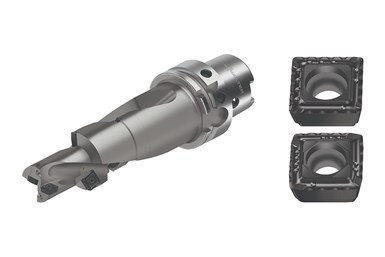Versatile Drilling Grade for Drilling Aluminum
This grade is designed to enable reliable chip removal due to its smooth surface with a reduced tendency toward adhesion and buildup on the cutting edge, thereby increasing process reliability and wear resistance.
Share








Hwacheon Machinery America, Inc.
Featured Content
View More
ECi Software Solutions, Inc.
Featured Content
View MoreWalter’s PVD drilling WNN15 grade for indexable insert drills is designed as a reliable, low-adhesion grade indexable insert drill. It is said this grade can be used specifically for drilling in tough ISO N materials such as wrought aluminum alloys or cast aluminum alloys. Primary areas of application include aerospace, automotive and general machining when weight reduction is key.
The grade is said to provide reliable chip removal due to its smooth surface with a reduced tendency toward adhesion and buildup on the cutting edge to offer process reliability and wear resistance for longer tool life, even at extremely high cutting speeds. This means that it can make indexable insert drilling more cost-effective than comparable PCD tools, the company says,
The indexable insert drills are said to offer the advantage of multiple indexing, which means the tool can be used again immediately and with comparably lower costs and less time required. It is said worn indexable inserts can be replaced quickly and easily.
This grade features a hard substrate on the indexable inserts, which is said to promote high cutting-edge stability. The PVD coating is created using the HiPIMS process, making a smooth, dense surface leading to a rake face surface that is said to perform better than a polished carbide surface.
An increase in the tool life of up to 200% can be achieved, depending on the application, compared to conventional drilling grades, the company says. The WNN15 drilling grades are available for most of the indexable insert drills in Walter’s portfolio, including D4120 (sizes 1-8), D3120 (sizes 1-7), and B3212.DF-B3214-DF (0.394-0.709 in. and 10-18 mm).
Related Content
-
Quick-Change Tool Heads Reduce Setup on Swiss-Type Turning Centers
This new quick-change tooling system enables shops to get more production from their Swiss turning centers through reduced tool setup time and matches the performance of a solid tool.
-
Custom PCD Tools Extend Shop’s Tool Life Upward of Ten Times
Adopting PCD tooling has extended FT Precision’s tool life from days to months — and the test drill is still going strong.
-
How to Mitigate Chatter to Boost Machining Rates
There are usually better solutions to chatter than just reducing the feed rate. Through vibration analysis, the chatter problem can be solved, enabling much higher metal removal rates, better quality and longer tool life.







































